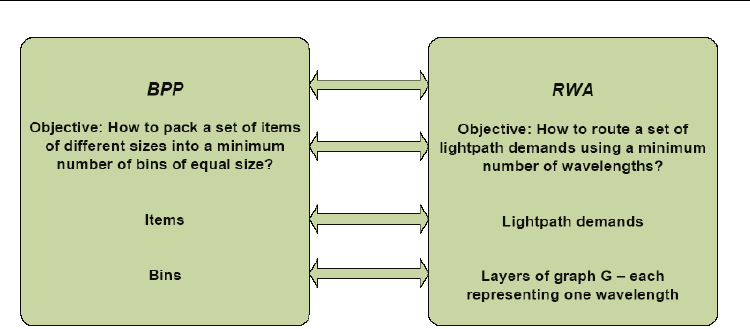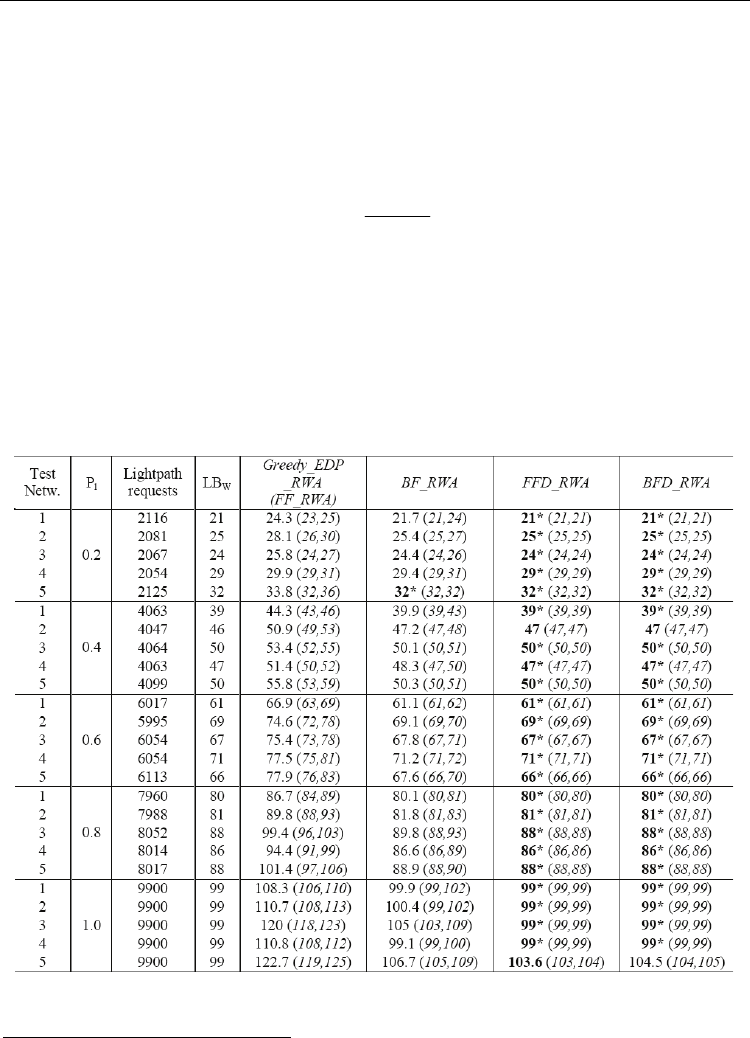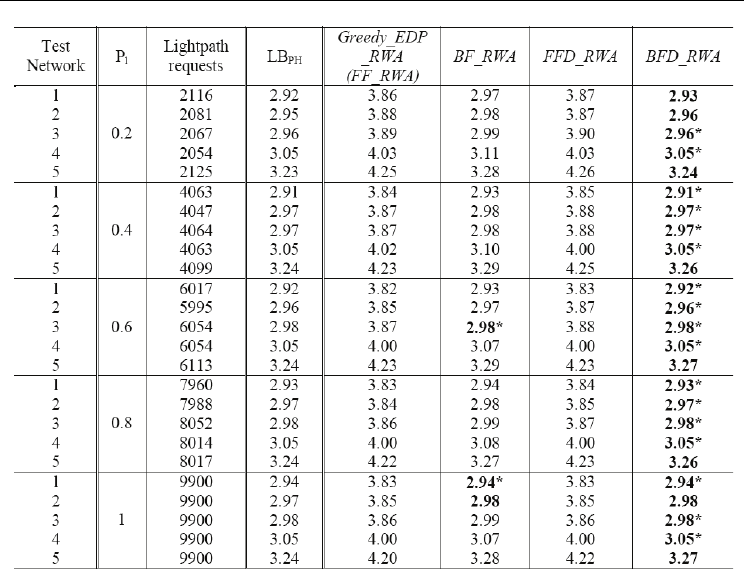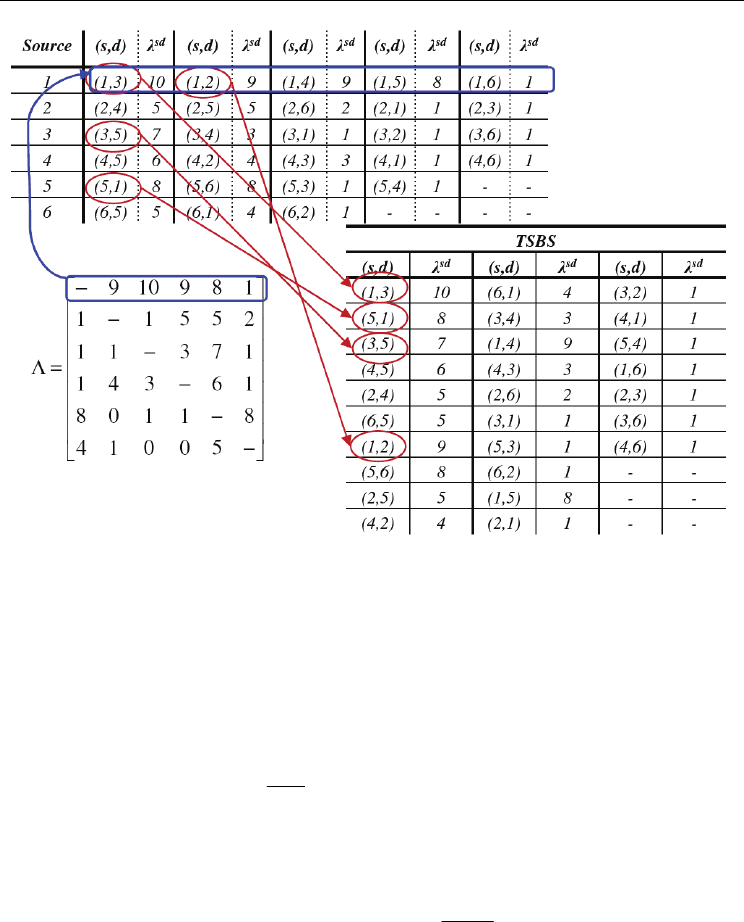Bednorz W. (ed.) Advances in Greedy Algorithms
Подождите немного. Документ загружается.


WDM Optical Networks Planning using Greedy Algorithms
571
wavelength converters and thus the entire physical path corresponding to a single lightpath
must be assigned a unique wavelength (the wavelength continuity constraint). Furthermore,
we constrain the length in hops of the paths in P by a parameter H.
Our objective is to minimize the number of wavelengths needed to establish the given set of
lightpath demands. A secondary objective we consider is minimizing the physical lengths of
the lightpaths which is desirable due to transmission impairments and delay.
2.2 Related work
The Routing and Wavelength Assignment problem has been widely studied in the
literature. This problem has been proven to be NP-complete (Chlamtac et al., 1992) and
several heuristic approaches have been developed to help solve it sub-optimally. Variations
have been studied, such as the static, scheduled and dynamic cases, with (un)limited
wavelengths, with(out) wavelength converters and/or considering physical impairments in
optical fibres ((Choi et al., 2000), (Jia et al., 2002), (Mukherjee, 1997), (Murthy & Gurusamy,
2002)).
In (Ramaswami & Sivarajan, 1995), a mixed integer linear formulation is given for the RWA
problem which is highly intractable and, thus, heuristics are needed. Alternative
formulations are given in (Ozdaglar & Bertsekas, 2003) which consider a quasi-static view
and introduce a cost function which is such that it tends to give integral solutions even
when the problem is relaxed.
Most heuristic approaches divide the problem into two sub-problems solved
subsequently: the first is to route the set of lightpaths and the second is to assign
wavelengths. Given a routing scheme, wavelength assignment is equivalent to the graph
coloring problem so existing heuristics for graph coloring are often used. In (Banerjee &
Mukherjee, 1996), the authors suggest a multi-commodity flow formulation for routing
which is relaxed and then rounded using a randomized approach. Wavelength
assignment is solved using graph coloring heuristics. Local random search is used to solve
the routing sub-problem in (Hyytia & Virtamo, 1998) while a greedy graph coloring
algorithm assigns wavelengths for the obtained routing solution. In (Noronha & Ribeiro,
2006), a tabu search algorithm suggested for color-partitioning is used to perform
wavelength assignment on a set of previously calculated alternative routes. Two-step
algorithms, such as those mentioned above, can give good results but may have longer
execution times than one-step algorithms.
A one-step approach is suggested in (Lee et al., 2002) which gives an integer formulation
solved using column generation. This, however, is not practical for larger problems. A
simple yet highly efficient greedy algorithm, called Greedy_EDP_RWA is suggested in
(Manohar et al., 2002). This approach is based on edge disjoint paths and runs as follows.
The algorithm creates a partition of the set of lightpaths where each element of the partition
contains a subset of the given lightpaths routed on mutually edge disjoint paths which can,
thus, be assigned the same wavelength. Hence, the number of wavelengths required is equal
to the number of elements in the partition. This algorithm has been shown to give better
results than (Banerjee & Mukherjee, 1996) and yet is much faster. We suggested improved
greedy algorithms based on bin packing in (Skorin-Kapov, 2006.a) which will be described
in more detail in the next subsection. Efficient implementations of these greedy bin packing
algorithms were suggested in (Noronha et al., 2008).

Advances in Greedy Algorithms
572
Fig. 2. Analogies between the Bin Packing Problem and Routing and Wavelength
Assignment
2.3 Greedy algorithms based on bin packing
In order to efficiently solve RWA using fast greedy algorithms, we adapt classical bin
packing heuristics to meet the specific demands of our problem. Bin packing is a well-
known NP-hard optimization problem which attempts to pack a given set of items of
various sizes into the minimum number of bins of equal size. Various heuristic algorithms
have been proposed for bin packing and surveys can be found in (Coffman et el., 1996) and
(Coffman et al., 2002). Widely-used greedy heuristics for this problem are the First Fit (FF),
Best Fit (BF), First Fit Decreasing (FFD), and Best Fit Decreasing (BFD) algorithms. The First
Fit algorithm packs items into the first bin into which it fits, while the Best Fit algorithm
pack items into the bin which leaves the least room left over after including the item. Both
algorithms pack items in random order, and as such can be used as online algorithms which
pack items in the order that they appear.
The FFD and BFD algorithms, on the other hand, must have a priori knowledge of the entire
set of items to be packed. Namely, they sort items in non-increasing order of their size and
then pack them according to the FF or BF strategies, respectively. The motivation for this is
that first packing the larger items, which are more difficult to pack, and then filling up
remaining spaces with smaller items often lead to fewer bins needed. The FFD and BFD
algorithms can only be used as offline algorithms since they require complete knowledge of
the problem (i.e. the set of items), but give much better results than the corresponding
online algorithms.
We apply these ideas to help develop efficient greedy algorithms for the static RWA
problem. We call these heuristics the FF_RWA, BF_RWA, FFD_RWA, and BFD_RWA
algorithms. To apply the Bin Packing Problem (BPP) to RWA, we have to define items and
bins in terms of optical networks which we do as follows. Items represent lightpath
demands while bins represent layers or copies of the physical topology, i.e., graph G, each
corresponding to one wavelength. Our objective is to route all the lightpath demands on
the minimum number of layers such that lightpaths routed on the same layer are edge
disjoint.

WDM Optical Networks Planning using Greedy Algorithms
573
2.3.1 The FF_RWA algorithm
The First Fit Routing and Wavelength Assignment (FF_RWA) algorithm runs as follows.
Lightpath demands (i.e., items) are selected at random and routed on the lowest-indexed
layer
1
of graph G (i.e., bin) that has a feasible path available and assigns to it the wavelength
corresponding to that layer. If there is no feasible path available on any existing layer, i.e. a
path shorter than the hop bound H, a new layer is added. Once a path is found, its
corresponding edges are deleted, i.e., are marked as used for that wavelength. Note that,
using this approach, a lightpath may be routed on a longer path on a lower-indexed layer
than might be available on a higher layer. Lightpaths in RWA, as opposed to items in BPP,
are not of fixed size but depend on the available links in each layer. This algorithm is
basically equivalent to the Greedy_EDP_RWA algorithm from (Manohar et al., 2002),
differing only in the order in which some steps are executed, but yielding the same results.
2.3.2 The BF_RWA algorithm
The Best Fit Routing and Wavelength Assignment (BF_RWA) algorithm also starts with a
single layer and routes lightpath demands in random order. However, instead of routing
lightpaths on the first layer on which there is an available path, lightpaths are routed on the
layer on which it ‘fits best’. By best fit, we do not mean the layer with the least room left over
as in BPP, but rather the one on which the lightpath can be routed on the shortest path. If
there are multiple layers which can offer routes of the same path length, the lowest–indexed
one is chosen. If there is no feasible path available on any layer, a new one is added. The
main motivation for this approach is to use fewer resources for individual lightpaths leaving
more room for future demands and ultimately minimizing the number of wavelengths used.
Additionally, this approach helps to minimize the physical lengths of the lightpaths.
2.3.3 The FFD_RWA and BFD_RWA algorithms
The First Fit and Best Fit Decreasing Routing and Wavelength Assignment (FFD_RWA and
BFD_RWA) algorithms sort the lightpath demands in non-increasing order of the lengths of
their shortest paths in G and then proceed according to the FF and BF strategies,
respectively. We use a lightpath’s shortest path in G as a measure of its size, even though
the lightpath will not necessarily be routed on this path. The motivation for this method of
sorting is that if ‘longer’ lightpaths (i.e. those that are harder to route) are routed first, when
most resources are still available, they can be routed on their shortest paths using up less
space. ‘Shorter’ lightpaths are then more easily routed over the remaining links which can
ultimately lead to fewer wavelengths used.
2.4 Lower bounds
To asses the value of the obtained solutions we compare with simple lower bounds which can
be easily calculated even for larger problems. A lower bound on the number of wavelengths is:
1
()
max ,
2| |
max
W
n
j
j
l
p
iV
lSP
LB
E
=
∈
Δ
=
Δ
⎧
⎫
⎡
⎤
⎡⎤
⎪
⎪
⎢
⎥
⎨
⎬
⎢⎥
⎢
⎥
⎢⎥
⎪
⎪
⎢
⎥
⎢
⎥
⎩⎭
∑
(1)
1
Initially, only one layer of G is considered.

Advances in Greedy Algorithms
574
The first element represents the maximum ratio of logical in (or out) degree Δ
l
to physical in
(or out) degree Δ
p
rounded to the highest integer. The second element represent the sum of
the lengths in hops of the shortest paths l(SP
j
) for all lightpath demands, divided by the total
number of edges |E|, multiplied by 2 (since they are bidirectional).
A simple lower on the average physical lengths is simply the sum of all the shortest paths
l(SP
j
) divide by the number of lightpaths n:
1
()
n
j
j
H
lSP
LB
n
=
=
∑
(2)
2.5 Computational results
The Greedy_EDP_RWA algorithm from (Manohar et al., 2002) and the BF_RWA, FFD_RWA,
and BFD_RWA were implemented in C++ and run on a PC powered by a P4 2.8GHz
processor.
2
Series of 5 random 100-node networks were created with average degrees of 3, 4,
and 5. Sets of random lightpath requests were generated where the probability P
l
of there
being a lightpath between two nodes ranged from 0.2 to 1, in 0.2 increments. The upper
bound on the physical hop length H was set to max(diam(G), √|E|) as in (Manohar et al.,
2002). All algorithms were run with 10 different seeds for each test case.
Table 1. The number of wavelengths obtained by the greedy RWA algorithms and the lower
bound for 100-node networks with an average degree of 4.
2
The FF_RWA algorithm was not implemented due to its basic equivalency with Greedy_EDP_RWA.

WDM Optical Networks Planning using Greedy Algorithms
575
Table 2. The average lightpath length (in hops) of the solutions obtained by the greedy RWA
algorithms and the lower bound for 100-node networks with an average degree of 4.
In Table 1, the average number of wavelengths of the solutions obtained by the
implemented algorithms and the lower bounds for networks with an average degree of 4 are
shown. Furthermore, the lowest and highest values for each test case are shown in
parenthesis while the best obtained solutions among the tested algorithms are marked in
bold. Those solutions which are equal to the lower bound, i.e. that are known to be optimal,
are marked as ‘*’. We can see that the FFD_RWA and BFD_RWA algorithms significantly
outperform Greedy_EDP_RWA and BF_RWA and give optimal solution for all but two test
cases.
In order to further asses the quality of the obtained solutions, we recorded the average path
lengths of the lightpaths established for each test case. Table 2 shows the results for
networks with an average degree of 4. We can see that here the ‘Best Fit’ strategy helps
obtain significantly shorter lightpaths than the ‘First Fit’ strategy, while the BFD_RWA
algorithm gives the best results in all test cases. The results for networks with average
degree of 3 and 5 are omitted for lack of space but can be found in (Skorin-Kapov, 2006.a).
Although all four algorithms are very fast and tractable, running under half a second for the
cases tested, the Greedy_EDP_RWA and BF_RWA are slightly faster than the FFD_RWA and
BFD_RWA algorithms due to the time spent sorting the lightpaths in the latter. However, as
a result of sorting lightpaths, FFD_RWA and BFD_RWA usually give the same results for
any order of lightpaths (unless all lightpaths are of the same length) and thus only need to

Advances in Greedy Algorithms
576
be run once, while Greedy_EDP_RWA and BF_RWA should be run as multi-start algorithms
in order to obtain good solutions.
3. The VTD problem
3.1 Problem definition
The Virtual Topology Design problem includes determining the set of lightpaths to be
established on the basis of a traffic matrix, performing RWA, and lastly routing packet-
switched traffic over the established virtual topology. Given is the a graph G=(V, E)
representing the physical topology and a long-term traffic matrix Λ representing the
estimated average traffic flows between pairs of nodes. Furthermore, we have given a
limited number of transmitters and receivers, commonly referred to as transceivers T, a
maximum number of wavelengths W, as well as an upper bound on the number of hops H
in the physical paths of lightpaths.
Various objectives can be considered. The most common optimization criteria used for
Virtual Topology Design are the minimization of congestion and average packet hop
distance. Congestion is defined as the maximum traffic load on any lightpath. The average
packet hop distance is the average number of lightpaths a packet or unit of traffic traverses
on its way from source to destination. Traversing multiple lightpaths incurs additional
delay due to opto-electronic and electro-optic conversion encountered when going from one
lightpath to the next. Both congestion and average packet hop distance are functions of the
virtual topology and the traffic matrix, while they are independent of the physical topology
and RWA scheme.
An objective criterion which has been gaining more and more attention lately is the
minimization of transmitters and receivers since they make up for most of the network cost.
An additional objective was proposed in (Skorin-Kapov, 2007), called the virtual hop
distance, which minimizes the average hop distance between any two nodes in the virtual
topology. Minimizing this criterion ensures that the virtual topology is well connected for
all node-pairs, which can postpone costly reconfiguration in case of changing traffic trends.
Minimizing the physical lengths of lightpaths is also desirable due to delay and, more
importantly, physical impairments which can cause signal degradation. Considering all
these objectives and their trade-offs is important to successfully solving the VTD problem.
3.2 Related work
Several approaches have been proposed to solve VTD or a combination of its sub-problems
using mixed-integer linear formulations (MILPs) with various constraints. A formulation for
complete VTD with the objective to minimize the average packet hop distance with full
wavelength conversion is given in (Banerjee & Mukherjee, 2000). Heuristics for the same
problem are given in (Mukherjee et al., 1996). The problem with no wavelength conversion
is formulated in (Ramaswami & Sivarajan, 1996) with the objective to minimize congestion,
but with no a constraint on the number of wavelengths available. Since the formulation is
intractable for larger problems, the authors suggest various heuristic algorithms. One of
them is the LP Logical Design Algorithm (LPLDA) which solves a relaxation of the
proposed MILP and rounds the virtual topology variables; RWA is not considered.
Alternative rounding schemes to obtain better solutions from LP-relaxations were proposed
in (Skorin-Kapov, 2007).

WDM Optical Networks Planning using Greedy Algorithms
577
Another heuristic suggested in (Ramaswami & Sivarajan, 1996), which is best-known, is the
Heuristic Topology Design Algorithm (HLDA). HLDA is a greedy algorithm for the VRWA
problem with a limited number of wavelengths and no wavelength conversion. Recall that
Virtual topology and Routing and Wavelength Assignment (VRWA) problem consists of the
first three sub-problems in Virtual Topology Design. The fourth sub-problem, Traffic
Routing (TR), is solved subsequently using an LP formulation with the objective to
minimize congestion. HLDA attempts to establish lightpaths between nodes in decreasing
order of their estimated traffic, where each lightpath is routed on its shortest path and
assigned the lowest-indexed wavelength available. After establishing a lightpaths, the value
of its corresponding traffic is decreased by the value of the next highest traffic demand (or
set to zero if the next highest traffic demand is higher) and then the traffic demands are re-
sorted. This enables multiple lightpaths to be established between pairs of nodes with high
traffic. Once the procedure ends, additional lightpaths are set up at random between nodes
with left-over transmitters and receivers. This algorithm is simple, and yet performs very
well with respect to congestion for which it was tested.
In (Krishnaswamy & Sivarajan, 2001), a MILP formulation for VTD including a limit on the
number of wavelengths and allowing no wavelength conversion is given. Since the
formulation is intractable, its relaxation is solved iteratively 25 times using a cutting plane,
after which the lightpath selection and lightpath routing variables are rounded. Wavelength
assignment is performed subsequently using a heuristic, while traffic routing over
lightpaths is solved with an LP composed of only the traffic constraints from their MILP for
VTD. This method gives good results but can be computationally prohibitive and does not
guarantee a solution with the constrained number of wavelengths due to the subsequent
wavelength assignment heuristic.
In (Zang & Acampora, 1995), the VRWA problem is solved by constraining potential
lightpath routes to their shortest paths, and then assigning wavelength subsequently to as
many lightpaths as possible in descending order or traffic, subject to the wavelength clash
and continuity constraints. This approach utilizes resources well, but significantly limits
possibilities by using predetermined shortest paths. In (Puech et al., 2002) a method to
reduce the complexity of the first and last sub-problems of Virtual Topology design, i.e.
lightpath selection and traffic routing, are given. In (Kuri et al., 2002), a tabu-search
algorithm for lightpath selection and traffic routing is presented, while the trade-offs
concerning cost and congestion are studied.
3.3 Greedy algorithms each aimed to optimize different objective criteria
Due to the many aspects and evaluation criteria important for VTD and its sub-problems, it
is challenging to develop heuristics which perform well for all criteria. We propose 4 greedy
heuristics for the VRWA problem (Skorin-Kapov, 2008), each aimed to optimize various
optimization criteria, and then solve Traffic Routing using an LP formulation from
(Krishnaswamy & Sivarajan, 2001) which minimizes congestion.
3.3.1 The TSO_SP algorithm
The first greedy algorithm considers Traffic Sorted Overall and routes it on the Shortest Path
available (the TSO_SP algorithm). A layered graph approach is used, as in the bin packing

Advances in Greedy Algorithms
578
algorithms for RWA, but with a limited number of layers W. First the traffic demands are
sorted in non-increasing order giving us an ordering of node-pairs which will be considered
as potential lightpath demands. For each node pair in the defined order, a lightpath is
established on the layer on which there is the shortest path available. If there is no feasible
route available on any of the W layers, the lightpath between the node-pair in question is
simply not established. If a lightpath is set up, the links along its path are deleted from the
corresponding layer, i.e. are marked as used. This approach is similar to HLDA except that
multiple lightpaths are not established between pairs of nodes and the transmitters and
receivers not used initially are not subsequently assigned to random lightpaths since one of
our objectives is to minimize transceiver cost.
3.3.2 The TSO_FS algorithm
The TSO_FS algorithm also Sorts Traffic Overall, but routes lightpaths on the First
Satisfactory path available. Basically traffic demands are sorted in non-increasing order and
corresponding potential lightpaths are routed on the lowest-indexed layer on which there is
a satisfactory path available. We consider a path satisfactory of its length is less than the
upper bound on the hop length H. If there is no satisfactory path available, the lightpath is
dropped. The motivation for ‘filling up’ lower-indexed layers is to leave higher layers empty
and potentially minimize the total number of layers used, i.e. the total number of
wavelengths used.
3.3.3 The TSBS_SP algorithm
In the TSBS_SP algorithms, Traffic is Sorted By Source and routed on the Shortest Path
available. Instead of sorting traffic between all node pairs, or potential lightpaths, in non-
increasing order we do the following. For each node separately, we sort the traffic demands
originating from that node to all other nodes (i.e. the row in the traffic matrix corresponding
to the node in question) in non-increasing order. Then we make a single ordering of traffic
demands, i.e. node pairs, by taking the highest traffic demand from each node, starting with
the highest one overall and continuing in decreasing order. Then we take the next highest
traffic demand, and the third, and so on until all traffic demands are included in the list. An
example of such a method of sorting is shown in Fig. 3. Once the traffic demands are sorted,
the algorithm tries to establish lightpaths in the specified order by routing them on the layer
with the shortest path available. The motivation for this approach, with respect to sorting
the lightpaths, is to create a virtual topology which is spread out more evenly and not only
concentrated around a few nodes with very high traffic. This could lower the average virtual
hop distance as well as prevent unconnected virtual topologies when resources are very
scarce which can cause traffic to be blocked between certain nodes, i.e. giving infeasible
solutions to the VTD problem.
3.3.4 The TSBS_FS algorithm
The TSBS_FS algorithm also considers Traffic Sorted By Source but routes lightpaths on the
First Satisfactory path available. Basically, after sorting the node pairs according to the TSBS
strategy, lightpaths are established on the lowest-indexed layer that has a satisfactory path
available.

WDM Optical Networks Planning using Greedy Algorithms
579
Fig. 3. An example of sorting a traffic matrix using the TSBS method.
3.4 Lower bounds
Lower bounds on the average packet hop distance and congestion were developed in
(Ramaswami & Sivarajan, 1996) and are as follows. Assuming P = (p
sd
) is the average traffic
distribution matrix, where p
sd
is the probability that there is a packet from s to d, Π
i
for 1 ≤ i
≤ N is a permutation of (1,2,…,N) such that p
i Πi (j)
≥ p
i Πi (j’)
if j ≤ j’. If Δ
l
is the maximum
degree of the virtual topology, the lower bound on the average packet hop distance was
shown to be
∑∑ ∑
==
−
+=
−
=
N
i
m
k
N
nj
)j(i
LB
p
k
i
pH
11
1
1
1
π
(3)
where m is the largest integer such that
1
1
1
1
−
−
=+++>
−
l
m
l
m
ll
N
Δ
Δ
ΔΔ
… (4)
and
,n
k
i
i
lk
∑
=
=
1
Δ
for 011
0
=
−
=
−
≤
≤
n,Nn,mki
m
. (5)

Advances in Greedy Algorithms
580
Since we consider a limited number of wavelengths W on each link, the virtual degree
cannot exceed W*Δ
p
, where Δ
p
is the maximum degree of the physical topology, we define
the maximum degree of the virtual topology Δ
l
to be
).W,Trmin(
pl
ΔΔ
⋅=
(6)
Using the lower bound for the average packet hop distance described above, a lower bound
on congestion was derived in (Ramaswami & Sivarajan, 1996) as
E
Hr
LB
p
LB
max
⋅
=
λ
, (7)
where r is the total arrival rate of packets to the network and E is the number of directed
links in the virtual topology.
A lower bound on the average virtual hop distance was derived in (Skorin-Kapov, 2007) as
follows. Since the average virtual hop distance is independent of the traffic matrix, the lower
bound on the average virtual hop distance from any node s in V to all the other nodes in the
network is the same for each node s. As noted in (Ramaswami & Sivarajan, 1996), if a
network has a maximum logical degree of Δ
l
, for some node s in V there can be at most Δ
l
nodes one hop away from s, at most Δ
l
2
nodes two hops away, at most Δ
l
3
nodes three hops
away, etc. An ideal virtual topology with respect to virtual hop distance from some node s
to the remaining nodes in the network would be such a topology in which node s had Δ
l
neighbors, each of which had Δ
l
neighbors of their own without creating a cycle, and so on,
until all the nodes were connected.
Let m be the largest integer such that N ≥ 1+ Δ
l
+…+ Δ
l
m-1
= (Δ
l
m
- 1)/( Δ
l
-1) holds. In the ideal
virtual topology with respect to virtual hop distance from node s, Δ
l
nodes would be one
hop away from s, Δ
l
2
nodes would be two hops away, etc., up until Δ
l
m-1
nodes that would be
(m-1) hops away. The remaining (N-1)-( Δ
l
+… + Δ
l
m-1
) nodes would be m hops away. It
follows that the lower bound on the average virtual hop distance would be
()
()
()
1
1
1
1
11
1
1
2
1
1
1
1
1
−
⎟
⎟
⎠
⎞
⎜
⎜
⎝
⎛
−
−
−+
⎥
⎥
⎦
⎤
⎢
⎢
⎣
⎡
−
+−−
=
−
−−+
=
−
−
=
−
=
∑∑
N
Nm
mm
N
N[mk
H
l
m
l
l
m
l
m
l
l
m
k
k
l
m
k
k
l
LB
v
Δ
Δ
Δ
ΔΔ
Δ
ΔΔ
(8)
Lower bounds on the number of wavelengths, transceivers and average physical hop
lengths of the lightpaths are not relevant for our particular problem, i.e., they would be zero
since there is no minimum number of lightpaths which must be established.
3.5 Computational results
The greedy algorithms for the VRWA problem described above were implemented in C++
and run on a PC with a P4 2.8 GHz processor. CPLEXv6 solver was used to solve the LP for
Traffic Routing. The algorithms were tested on a 14-node reference European core network
topology from (Inkret et al., 2003) shown in Fig. 3. The algorithms were tested for two
different traffic matrices, p1 and p2, used in (Ramaswami & Sivarajan, 1996) and
(Krishnaswamy & Sivarajan, 2001) to test VTD. In traffic matrix p1, most of the traffic is
